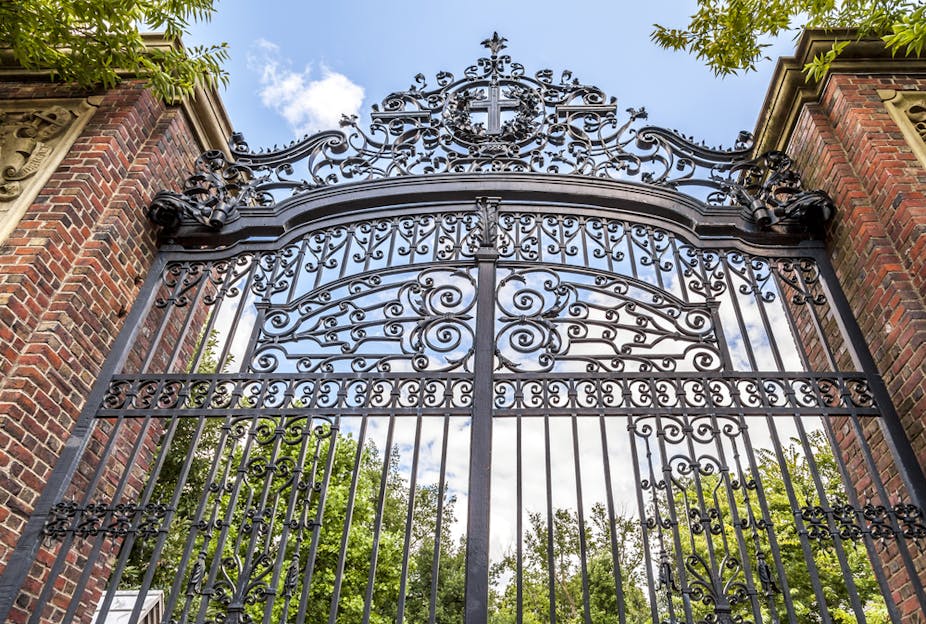Proposed changes in the budget to higher education fees and loans have sparked widespread protests by students. They argue the university sector without a cap on fees, as the budget proposes, will become the elite model seen in the US and lead to growing inequality.
Education Minister Christopher Pyne lauded the American higher education model when he said “we have much to learn” from our “friends in the United States”.
The government has proposed three big changes to higher education: deregulating fees, lowering government subsidies for student places and charging real interest on HELP loans.
What is the “American Model” and will these changes really take us there?
Looking at Australian and American universities in 2014, the differences are diversity and debt.
In Australia, all of our universities are funded under a single model and student fees are capped. As a result there are only modest differences between our institutions.
In contrast, the American model has been deregulated to allow vast differences between universities. To give an idea of the disparity, annual tuition fees at elite universities can be enormous ($44,000 at Harvard) while the lower tier of regional universities charge significantly less ($4,500 at New Mexico Highlands University).
This desire for diversity is Pyne’s way of saying that he wants our top universities to be better and compete with the Harvards of the world, even if the cost is that other universities are worse off.
The government has said its main priority for higher education is “not getting left behind”. It wants more of our universities in the top 50 in the world. (Pyne litters many of his speeches with commentary on our status within the university world rankings, despite significant criticisms of how meaningful they are.) Deregulating fees is designed to create the disparity that will enable this, universities with a strong reputation to charge higher fees will increase quality, and lower status universities will have to compete on price rather than quality.
The second part of the US model is student debt. In Australia in 2014, the government provides student loans through the HECS-HELP scheme. Students pay the loan back at a rate that rises with income, with payments only kicking in once loan holders are earning over a certain threshold (currently $53,345).
The public purse contributes significantly to the cost of higher education in the form of this below-market rate of interest as well as debts that do not get paid back.

In 2014, students in the US are eligible for a federal loan with an interest rate linked to the US Federal 10-year Treasury rate, plus a small margin. The rate is currently 3.86%, although students who have financial need have this interest subsidised by the government. In addition, all students taking out loans pay a 1% loan fee.
The 2014-15 budget proposal to link student debt to government 10-year Treasury bonds would bring Australia directly in line with the US model. Pyne’s claim that profits used from the loans will subsidise students with financial need is yet to be fully described, but also appears to be in line with the US model of subsidies for students in need. Like the US system the changes move towards a “user pays” model, in which the combination of higher fees and the introduction of real interest on debts will move the cost of studying onto individual students.
The American student debt problem
While the government’s main concern is raising the quality of our top universities, many academics and students are concerned about the social and economic problems the US model has caused.
There is evidence from around the world that higher fees disproportionately affect students from low socio-economic backgrounds. The prospect of high levels of debt discourages these students from attending university, and students from low socio-economic backgrounds and women on average take longer to pay off debts and are hardest hit by interest. Professor Bruce Chapman, who designed the current HECS system to combat these factors, is one of the many critics of the changes.
Shifting the burden of paying for education away from the public purse (coming largely from taxes on high income earners, generally the previous generation) and onto individual students is something a nation can only do once. The government that implements such a change can claim “savings”, but there are hidden negative consequences.
Student debt in the US is causing what some academics have called a “crisis of justice”, affecting the everyday lives of students who are still paying off their student debt years after graduating. One group that suffers most from higher fees are those students who for a range of reasons drop out of university before completing their degree.
The level of debt in the US has not just led to social inequity but also wider economic problems. For example, high levels of student debt directly correlate with the decreasing number of loans for homes and cars being taken out by young adults. In other words, student debt may be having a negative impact on the national economy.
And in case there is any doubt fees will rise, the US example shows that fees have risen at a rate that far outstrips inflation. In the ten years to August 2013 the CPI (inflation) was 26.1% while the cost of tuition rose 79.5%.
One reason for higher fees is that deregulating universities opens them up to market forces, obliging them to do what it takes to stay competitive. In the US a senate committee found that on average 23% of the budget of for-profit universities was being spent on marketing.
The reason students have been marching in the streets should not simply be seen as a knee-jerk reaction to being asked to pay more. It should be taken as a response to the government’s desire to emulate the American model. The students protesting, supported by a host of academics, are saying that embracing the US system is not what they want for the future of higher education in Australia.

